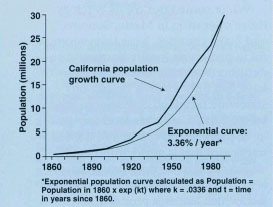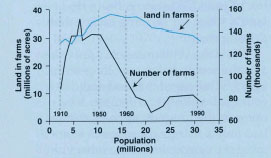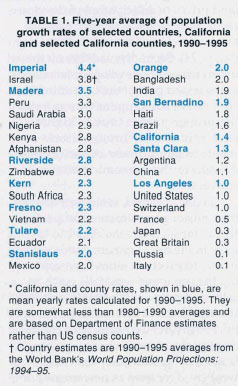All Issues
Urban growth squeezes agriculture
Publication Information
California Agriculture 52(3):8-9. https://doi.org/10.3733/ca.v052n03p8
Published May 01, 1998
PDF | Citation | Permissions
Full text
A century ago, the state was populated by 1 million Californians—about the same number who now attend the Rose Bowl Parade every Jan. 1.
Today's state population is 33 times greater. The Department of Finance recently reported a 1.8% increase for the year ending July 1997 — 574,000 more people. The numbers signaled a resurgence of net migration and a continuing high rate of natural increase. The same figures showed that all but four counties grew, and Monterey and San Benito counties tied for the state's highest growth, at 4.9%.
Rapid growth is a century-long trend in California (fig. 1). Since the time of the Gold Rush, California's average yearly growth has exceeded 3.36% per year. Even when growth slowed during the recession of the early 1990s, California's fastest growing counties topped the growth rate of most countries in the world (table 1).
Fig. 2 Number of farms and land in farms versus population, 1910 to 1992. Source: U.S. Census Bureau, Censuses of Agriculture.
In recent decades, urban growth has led to farmland losses and changing economics for a number of farms. According to U.S. Bureau of the Census figures, the state lost close to 9 million acres of farmland between 1950 and 1993, a decline of almost 25%, from about 38 million to 29 million acres. As California's population continues to grow, so will urban land. By 2100, if current land-use patterns don't change, urban land in California could occupy one-third of the state — more area than is currently occupied by agriculture.
The reverse of a trend
For the first half of this century, farms and farmland increased along with California's population growth. But after 1950, the trend reversed. As population increased further, farmland declined (fig. 2). Urban populations moved into the agricultural mid-coastal valleys of Ventura and Monterey and San Luis Obispo and the fertile valleys east, north and south of San Francisco, dramatically transforming the landscape. Aerial photographs (see p. 9) show the consequences of this trend for the Santa Clara Valley.
Nevertheless, the volume of agricultural production has continued to increase to the present. Farmland losses were countered after World War II by massive irrigation projects such as the Central Valley Project, which allowed the expansion of intensive irrigated agriculture into otherwise arid grazing lands in the Southern San Joaquin Valley. Growers continued to adopt new technologies and crops, and further diversified, expanding from 200 commodities at the end of World War II to 350 crop and livestock commodities by 1996.
Despite increasing production, markets changed such that the value of the state's agricultural production experienced an extended decline after 1975, if figures are adjusted for inflation. In constant 1992 dollars, the 1975 value of production was $25 billion and the 1993 value of production was $18 billion. Production value has shown an upward trend in the past 5 years.
What lies ahead?
More recently, population has spread over the Tehachapis south of Bakersfield and over the coastal ranges into the fertile Central Valley. This time agriculture has nowhere to go. The children of dairy farmers who sold their San Bernadino operations and resettled in the Central Valley don't have the same options their parents had, because additional dairy land is not readily available in the state. Relocating orchards is no longer simple because there is less easily irrigated flat land.
TABLE 1 Five-year average of population growth rates of selected countries, California and selected California counties, 1990-1995
In addition, there are no more massive irrigation projects to turn deserts into fertile plains. Finally, urban populations now wish to preserve landscape for aesthetic and recreational purposes, as well as to enhance habitat for native creatures, purposes which may not be compatible with productive agriculture.
We are not yet close to losing the state's agricultural productivity. With a $24.5 billion farmgate value in 1996, agriculture remains a vital industry, and with 68% of its production exported (55% to other states), agriculture is an important economic contributor to local, state and national economies.
But we are faced with the prospect of huge dislocations and management dilemmas. For instance, agricultural employment remains critical to the economies of certain regions, most notably the San Joaquin Valley, where farm-related industries directly employ 8.5% of the total employees in all economic sectors. Central Valley farmland is the target of much planned population growth. If current trends continue, almost one-third of its irrigated cropland could be urbanized by 2040 (see map, p. 20). How do we accommodate new people in agricultural areas and maintain our productivity? How do we plan and manage for a future with many more people making increasing and conflicting demands on the state's land resources?
If agriculture is to have a long-term future in this state, we must acquire a better understanding of local land-use decision-making, as well as how, when and where the state's population is growing, and its agricultural impacts. Only then can we provide research-based information that will enable localities to make effective decisions concerning this important resource.







